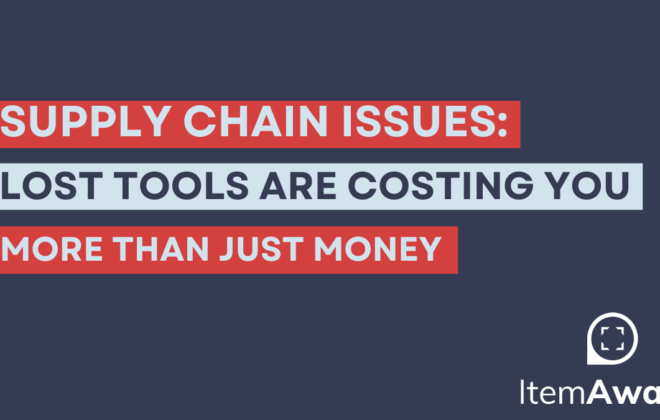Misplaced tools are costing you more than you might think. Aside from lost revenue, misplaced equipment significantly reduces productivity as employees allocate valuable time searching for missing tools. Supply chain issues only further exasperate this issue as essential equipment is becoming harder to replace quickly. The annoyance of losing a tool is no longer just a frustration – it’s becoming an out-of-control expense as inflation soars and productivity suffers.
Our intuitive tool tracking software, ItemAware, is the solution you need to avoid these issues altogether. Its robust capabilities give you 24/7 access to the last-known location of your equipment, ensuring that you’re never left wondering where your tools are again.
Continue reading to learn how ItemAware can protect your budget and maximum operational efficiencies by keeping your tools and equipment fully visible at all times.
You Can’t Afford for Your Team to Be Unproductive.
Professional expertise is hard to come by – and shouldn’t be wasted searching for a needle in a haystack.
When employees feel their skills are being wasted on menial tasks, their productivity suffers as they become disengaged and frustrated. Disengagement ultimately breeds a culture of unsatisfaction which quickly leads to inefficient, yet skilled workers who may choose to take their talent elsewhere. To further complicate matters, high turnover rates during a labor shortage is likely a recipe for disaster – especially when those quitting are highly talented employees.
According to SHRM, many factors will continue to reinforce the labor shortage for the foreseeable future including inflation, high rates of unemployment, a potential economic recession, and an aging population. Simply put, you cannot afford to lose your most talented employees because dedicated, skilled workers are becoming increasingly more difficult to hire.
Get your talented employees back to the job they were hired to do by implementing our modern tool tracking software, ItemAware. ItemAware makes accountability easy by giving you a full picture of who is using what equipment at any given time. This detailed inventory log nearly guarantees high levels of productivity as employees aren’t wasting time aimlessly searching for misplaced tools.
No Matter The Location, ItemAware Will Track Your Tools With Ease.
Did you know that the electrical utility industry estimates a 30% annual loss rate of tools; i.e., upwards of $900,000,000 “lost” items annually? We know we have shared this before, but the number is so staggering that it deserves repeating. Thankfully, there is a solution that can separate your business from this shocking statistic – and that solution starts with a tool tracking software that functions beyond warehouses.
Tools and equipment were never meant to be stored indefinitely. Your team transports these essential items in a variety of work trucks from jobsite to jobsite. The busier, more active your employees are, the more likely they are to unintentionally misplace tools; however, a fast-paced season shouldn’t deplete your inventory.
ItemAware was designed with the utility industry in mind. Because your employees rarely work at the same site two days in a row, ItemAware is fully capable of tracking tools in work trucks, sheds, warehouses, and at any jobsite. A quick glance at our secure mobile app will show you the exact location and status of your tools, eliminating the worry of misplaced equipment.
Supply Chain Issues Are Not a Thing of the Past.
Supply chain disruptions weren’t just a problem faced during the height of COVID-19 infections. Given the ongoing unstable environment surrounding supply chains, it is becoming increasingly more important to keep the equipment you have to avoid lost revenue due to fulfillment delays.
Your customers are loyal but they also have jobs to get done. Habitually delaying projects due to a lack of sufficient tools – coupled with an inability to restock them quickly – is going to significantly cut your revenue streams as companies begin taking their business elsewhere. Put an end to this financial bleed by partnering with Aware Innovations to ensure that your team always has the tools they need whenever, wherever they need them.
Tool Duplication Impacts More Than Just Your Storage Space.
What’s worse than wasting time? Wasting money. Tool duplication is not only expensive but is also causing you the unnecessary stress of fighting supply chain issues to replace equipment that you already have on hand.
One of our current customers (anonymity requested) stated, “[i]n the time that we’ve had ItemAware running, we’ve never had to buy another tool…if we reduce our tool loss by 20%, we could save millions”.
There is a big, costly difference between items that are misplaced vs. lost. Stop spending money duplicating your misplaced equipment by investing in our innovative asset tracking software. ItemAware will efficiently track your tools, equipment, materials and more so that you don’t have to. With our cutting-edge software on your side, you will never again spend money replacing tools that were never truly lost.
ItemAware Is Your Partner in Avoiding Supply Chain Issues.
Supply chain issues are here to stay – and so is ItemAware. Partner with Aware Innovations to avoid unnecessary tool loss that destroys your budget and obstructs employee productivity.
Your tools must be tracked to keep your inventory current, but you don’t have to be manually responsible. Our team would love to talk to you about how ItemAware can track your assets for you, saving you both time and money.
Get started today by requesting a free 30-minute demo with one of our knowledgeable representatives.
About the Author
Jessica Frye is an expert content writer with 7+ years of professional writing experience. She earned her B.A. in Communication Studies from Wright State University and has worked alongside companies in both the for-profit and non-profit sectors. Jessica is passionate about community and enjoys using the power of words to not only cause people to react but to take initiative.
